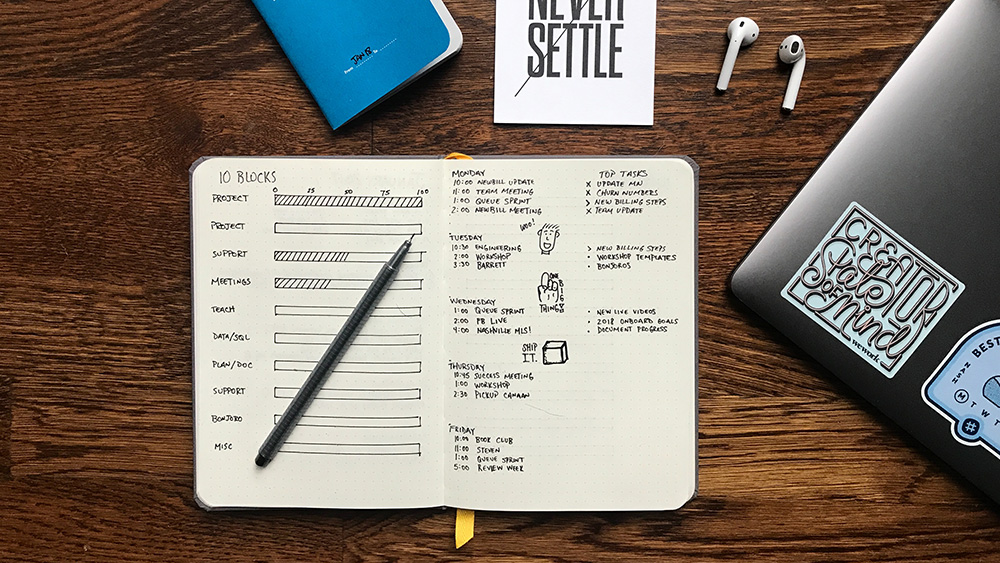Time management tips: How to streamline your workflow
Improve your productivity in four simple steps.

Everyone has too many things to get done. There are, in any given person’s life, an almost endless amount of tasks, projects and things to do. They range from the boring (routine work tasks, mowing a lawn or doing homework) through to fun (a date, a game, playing with the kids) to the original (a challenging new project at work, getting to grips with a new website builder or planning a party). No matter what, though, you can create more free time if you think carefully about managing your time.
Time management is almost no one’s favourite topic to discuss. It brings to mind schedules and lists, often triggers yawns and perhaps causes some of us to get out a buzzword bingo card or two. However, if you make it a goal to use some very basic tools and habits to manage your time, you can really change the way your day works. You can be more productive on the job and complete more tasks (using less time).
There are several facets to time management that we can investigate. In this article, we'll explore some practical ways to improve your productivity and help you organise your days better.

Tip #1: Track your working time (and your breaks)

The key thing to focus on is actually keeping track of your working time and, just as importantly, your breaks. As the workday goes on, people generally begin to work less efficiently. Everyone has experienced the slow burn as they lose attention, become tired or simply find themselves less effective at their job the more hours they are 'on the clock'.
This can also present itself in subtle, harder-to-identify ways: slower reaction times, less creative energy and other effects that can hinder you without raising red flags. You may not be falling asleep at your desk but your body and, more importantly, your mind, is recognising the strain anyway. This tendency to work 'harder' by working long hours without ceasing often simply results in low productivity and people who are no longer doing quality work.
Focus can also be a challenge during the workday. Many of us try hard to multitask but science has shown us again and again that human brains are better at focusing on one task at a time.
One way to combat this stress of constant work and stay focused on one thing at a time is to think of your time as if it were split up into two categories:
- Task-focused work: Blocks focused on getting a single task done
- Breaks from work: These allow you to disconnect, recharge and relax
There are a couple of working methods that can help improve your ratio of work to breaks, as well as boosting your single-task focus throughout the day.
Solution: The Pomodoro Technique
The Pomodoro Technique is a simple way to break up your workday into chunks of productivity. You use a timer to clock the units of work (‘Pomodoros’). You can use a physical Pomodoro timer or download a phone app. You pick a single task and power through that task during a 25-minute working block (or customise the times to meet your needs). When done, you take a five- or 10-minute break, again with the timer, then start a new Pomodoro. You can concentrate on the same task again or pick a new one.
At the end of four Pomodoros, you take a longer break of maybe 20 to 30 minutes. The important part about the breaks is that they need to be breaks. Get up, talk to someone, talk a short walk, stretch, look out the window, read a book. Breaks aren’t for doing other work.
If you are interrupted during your Pomodoro, end the interruption as quickly as possible, jot down a note if there is another task you need to do because of it and continue with your work. Try not to get derailed: stay focused.
Solution: The Flowtime Technique
One thing that many people don’t like about Pomodoro is that the working blocks are so severely regimented. A consistent complaint is that you might finish a task in less time and not need the whole block or that you might be 'in the zone' when the timer goes off, which of course harms productivity rather than helping it.
You can solve this by using what is called the Flowtime Technique. Instead of hard limits for the timers, you try to work in flexible blocks of, for example, 20 to 60 minutes. The goal is not for every block to be the same but rather for each block to be a unit of cohesive, focused work on one task, with a maximum length so that you don’t work on that task for hours without a break. With this technique, you will just be stopping for a break when you need a break and trying hard to be honest about that.
Tip #2: Figure out where your time is going
A second important facet of working smarter rather than harder involves knowing when you have been working, on what, and why. Time tracking is a handy way to, over time, build up an idea of what you have actually been doing.
If you are using the Pomodoro or Flowtime techniques already mentioned, tracking your time will be that much easier. When you start a Pomodoro, you’ll just start a timer or jot down the time and when you finish, the same. Some Pomodoro apps can even do this for you and if you ever forget to write down starting or stopping times, the fact that you’re working in recorded chunks should make it easy to go back and grab that information later.
You can see patterns of what distracts you and when; you can see what times of the day are your most productive and for what types of work
Jeff Smith
Once you can gather enough of this data, it becomes invaluable to you. You can see patterns of what distracts you and when; you can see what times of the day are your most productive and for what types of work.
This will be your guide in restructuring the workday as much as possible to maximise your productivity – doing creative or complex work during your more productive times and filling the gaps between meetings, interruption-heavy time blocks and periods where you often have trouble focusing with more menial work.
Solution: Try a time tracking tool
There are low-energy solutions for tracking time spent in applications already for Windows, macOS and for the various phone platforms. You might use some of them already. These features enable you to see what applications you use and for how much time per day or week.
What we want to do is similar but on a task level. Rather than knowing whether you had Chrome or Slack open this afternoon and for how long, we instead want to know if you were in meetings or writing code, preparing taxes or writing customer communications.
One of the best free/cheap time tracking solutions out there is Toggl. Toggl has an app that is so-so for iOS and Android but the web service is superb and can be tied into services like Zapier or IFTTT for automation.
Additionally, there are other time tracking tools that are integrated into the software you already use. Employee time-card systems, if you fill out line items for tasks, are one. Another is the invoicing tool you use, if you freelance – many of those contain time tracking features as well, to help with generating those invoices.
Tip #3: Supercharge your to-do lists
Last, but certainly not least, consider the use of some sort of task-management system. These can vary wildly, from pencil and paper setups (see our guide to the best notebooks for designers) to phone apps or computer software. The goal is to keep track of all the items you need to do in a given day or for a given project and ensure things don’t get forgotten.
Task managers are useful in a lot of ways. You can simply use them as an organised to-do list if you wish but their real strength comes when you lean on them hard. Every new task that comes to mind gets dropped into an inbox, you sort tasks into projects, label them and you depend on the system absolutely. It can always be depended upon to guide you on what you should be doing, when and often where.
The system does need to be reviewed on a daily or weekly basis to make sure that tasks don’t fall between the cracks, buried at the bottom of a project with perhaps no due date. In essence, the task manager can be a second memory for the things that you need to get done.
An important distinction here is that we are looking at task management rather than project management. Project management tools, such as Trello, Basecamp, Asana and many others like them, are very different to task managers.
When we manage tasks, we’re thinking of to-do lists – what tasks need to be done at work or at home. Project managers are a much wider scope and less focused on individual tasks than on the entire breadth of the work that needs doing.
Solution: Keep a bullet journal

Your first choice will be whether you want an analog (paper) or digital (mobile/computer) system. If you intend to keep track of your tasks on paper, one of the best methods to manage it all is via Bullet Journaling. It’s an amazing system that enables you to capture thoughts, notes and tasks and works quite well alongside focus-driven Pomodoros (and also provides a place to note times for time tracking).
Solution: Use a digital time-tracker
If you’d prefer a digital time-tracking system, the best overall recommendation for any platform is Todoist. Todoist is an amazing application that lets you sort tasks into projects, nested projects, subtasks, labels, due dates and a whole mess of other features, while still letting you have a single simple to-do list if you’d like. Power users can share tasks with others, sync with calendars or even use the API to integrate with thirdparty services such as Zapier or IFTTT.
For Apple ecosystem users, the favourites are OmniFocus for serious task management with a more ‘Getting Things Done’ (GTD) flair and Things for everyone else. Both of these apps are amazing task managers and, for a macOS/iOS only user, can provide in some cases more useful features than even Todoist.
Tip #4: Combine your time management tools
These three parts of working smarter dovetail together very nicely. If you have a to-do list for the day, you can take an item off of that list, do a Pomodoro or two to complete it and then track the time you spent engaged with that task before picking another one.
This can be a lot to get used to at once, so it is also perfectly acceptable to take one of these ideas and incorporate it into your daily routine, then – once you’re familiar with using it regularly – consider the idea of looking into one of the others.
This article was originally published in issue 324 of net, the world's best-selling magazine for web designers and developers. Buy issue 324 or subscribe to net today.
Related articles:

Thank you for reading 5 articles this month* Join now for unlimited access
Enjoy your first month for just £1 / $1 / €1
*Read 5 free articles per month without a subscription

Join now for unlimited access
Try first month for just £1 / $1 / €1
Get the Creative Bloq Newsletter
Daily design news, reviews, how-tos and more, as picked by the editors.
